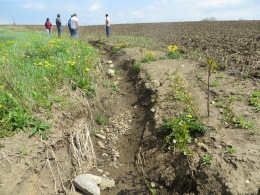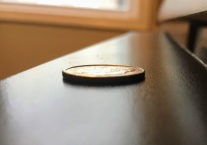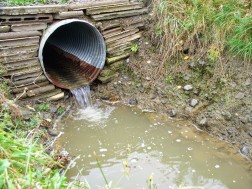(Part of a down to earth series on the foundation of sustainable agriculture)
 “What is soil erosion and how does that affect me?” That’s a fair question. Many of us do not see much soil during our workday. According to a recent USDA-NRCS article, 81% of the people in the United States live in urban areas. Maybe you may go by a park or see some trees planted in the median of the street, how would you know the soil is important to you unless someone explained why? After all, unless you get excited about soil you probably take it for granted. We never hear anything on the news about the loss of topsoil. It isn’t like we hear reports of someone robbing topsoil from some farm. But what if I was to tell you that millions of tons of topsoil are lost each year just in the United States! Truthfully, we have none to spare.
“What is soil erosion and how does that affect me?” That’s a fair question. Many of us do not see much soil during our workday. According to a recent USDA-NRCS article, 81% of the people in the United States live in urban areas. Maybe you may go by a park or see some trees planted in the median of the street, how would you know the soil is important to you unless someone explained why? After all, unless you get excited about soil you probably take it for granted. We never hear anything on the news about the loss of topsoil. It isn’t like we hear reports of someone robbing topsoil from some farm. But what if I was to tell you that millions of tons of topsoil are lost each year just in the United States! Truthfully, we have none to spare.
1.7 Billion Tons
That’s how many tons of soil we lost in the United States just in 2007 according to the

A ton of topsoil take as much space as this chest freezer
United States National Resource Conservation Service (NRCS), the nation’s office of natural resource stewardship, a part of the USDA. We are doing a much better job than in the 1980’s. Thirty-five years ago, we were losing over 3 BILLION tons of soil a year, much of it going down the ditches, streams, and rivers, dumping into the bays and estuaries of our nation. According to a 2006 study by Cornell University, it costs our nation $37 Billion dollars a year in lost food production due to the soil being literally washed away.
What do 1.7 Billion tons look like?
 We would think that such a loss must leave large holes in the farmland. Why hasn’t someone taken a picture of the huge craters made from such a large loss? That’s because you can’t hardly notice what 1.7 billion tons look like. Pull out a dime. See how thin it is? 1.7 billion tons is less than the thickness of a dime. That’s right, the thickness of a dime. Spread out over the entire farm and ranch acres in the United States, 1.7 billion tons of topsoil would equal a volume less than the thickness of a dime. What’s the big deal?? It’s because the really good dirt, (the dirt that makes lots of crops and food), is the top inches of the soil. We lose more than we ever add back to the soil.
We would think that such a loss must leave large holes in the farmland. Why hasn’t someone taken a picture of the huge craters made from such a large loss? That’s because you can’t hardly notice what 1.7 billion tons look like. Pull out a dime. See how thin it is? 1.7 billion tons is less than the thickness of a dime. That’s right, the thickness of a dime. Spread out over the entire farm and ranch acres in the United States, 1.7 billion tons of topsoil would equal a volume less than the thickness of a dime. What’s the big deal?? It’s because the really good dirt, (the dirt that makes lots of crops and food), is the top inches of the soil. We lose more than we ever add back to the soil. 
What’s the big deal?
How can soil loss thinner than a dime make a difference? The top one inch of the soil is thousands of time more active and full of very powerful substances. Things that interact with fertilizer, pesticides, roots, beetles, and the city of microbes that live around the roots of crops. This is a group of complex and very active organic compounds that we are just beginning to understand. Your nation lives by this soil. Farmers lose part of their farm when they lose soil-the best part. According to the Des Moines Register, Iowa farmers are perhaps losing $1 billion per year in profits due to soil erosion. If you lose farmers, you lose your meal. This was something well understood by ancient and not so ancient societies. Erosion takes time. It’s not sudden like an earthquake and it isn’t a highly concentrated strike of force like a tornado. It’s a slow but deadly process. Nations have collapsed because of its force. Erosion takes away the most alive part of the soil. Remember the dime.
Soil Health is critical to maintaining long-term social stability. As we make advancements in soil health we must not forget our past. It’s been about 90 years since the great Dust Bowl that crippled our nation’s farm and food security due to wind erosion of our topsoil. Costing the public hundreds of millions of 1930’s dollars, the government instituted programs that included farm bailouts and paying farmers not to farm soils that suffered the most severe erosions. It was out of the Dust Bowl that the Soil & Water Conservation District ‘s was formed so that we may never experience another natural catastrophe of that size again.

Water from the field bound for Owasco Lake
Soil health is critical. However, if we lose all the topsoil down our local drainage ditches, creeks, and rivers, our crop yields will suffer, farmers will go out of business, and our efforts for food security will be that much harder. Soil erosion reduction is vital for soil health efforts to succeed.
Here are the referenced links below. Thanks for reading!
https://www.nrcs.usda.gov/wps/portal/nrcs/main/soils/use/urban/
https://theweek.com/articles/554677/america-running-soil
https://www.nrcs.usda.gov/wps/portal/nrcs/detail/national/programs/farmbill/?cid=stelprdb1257899
https://www.nrcs.usda.gov/wps/portal/nrcs/detail/national/soils/?cid=stelprdb1041887
https://lib.dr.iastate.edu/cgi/viewcontent.cgi?article=1510&context=leopold_grantreports
https://crops.extension.iastate.edu/soil-erosion-and-crop-productivity-topsoil-thickness
https://www.youtube.com/watch?v=ohX1jIlH_kI&feature=youtu.be
https://www.cbsnews.com/pictures/depression-era-dust-storms/6/
https://www.weather.gov/gld/SevereWeather4-2-2015
https://www.ksnt.com/news/dust-storm-blankets-much-of-texas-panhandle/1024338370